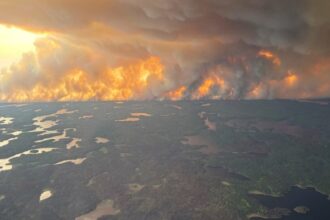In an unprecedented enforcement action that signals Nova Scotia’s zero-tolerance approach to forest fire prevention, provincial authorities have levied a staggering $28,000 fine against a man who violated a forest travel ban during last year’s devastating wildfire season. The penalty—the largest of its kind in recent memory—underscores the gravity with which officials are addressing fire risks as climate change intensifies drought conditions across Atlantic Canada.
The hefty fine was imposed after the individual entered a restricted woodland area in May 2023, during a period when the province was battling multiple out-of-control wildfires that ultimately destroyed homes and forced thousands of residents to evacuate. According to court documents, the man’s unauthorized presence required emergency resources to be diverted at a critical moment in firefighting efforts.
“This isn’t simply about punishing one person—it’s about sending a clear message that our forest protection measures are not optional suggestions,” said Provincial Natural Resources Minister Tory Rushton in a statement released Thursday. “When lives and property are at stake, we cannot afford to have individuals disregarding safety protocols that protect our communities.”
The 2023 wildfire season was particularly catastrophic for Nova Scotia, with the Tantallon fire alone consuming over 950 hectares and destroying approximately 200 structures in suburban Halifax. The crisis prompted the provincial government to implement its most restrictive forest access ban in decades, prohibiting all non-essential activities in wooded areas across the province.
Legal experts note that the unprecedented fine reflects a growing trend toward more severe penalties for environmental and safety violations. “Courts are increasingly willing to impose substantial financial consequences when public safety is jeopardized,” explained Dalhousie University environmental law professor Catherine Thompson. “This case represents a shift in how we view the collective responsibility to prevent natural disasters.”
Climate scientists have repeatedly warned that the Maritime provinces face heightened wildfire risks due to changing precipitation patterns and rising temperatures. According to Environment Canada data, Nova Scotia has experienced increasingly prolonged dry periods during spring and summer months—creating conditions that transform forests into potential tinderboxes.
The provincial Department of Natural Resources and Renewables has since expanded its wildfire prevention program, allocating an additional $4.7 million toward advanced detection systems and community education initiatives. Officials have also introduced a more nuanced restriction system that allows for graduated responses based on specific regional conditions rather than province-wide bans.
For residents like Sarah Mackenzie, who lost her Westwood Hills home in last year’s fires, the fine represents appropriate accountability. “When you’ve watched everything you own turn to ash, you understand why these restrictions matter,” she told reporters. “This isn’t about government overreach—it’s about preventing the kind of devastation that changes lives forever.”
As Nova Scotia approaches another potentially dangerous fire season, emergency management officials emphasize that public compliance remains their most effective prevention tool. The question that remains for policymakers and citizens alike: In an era of increasing climate instability, will dramatic penalties be enough to ensure collective adherence to safety measures that protect our increasingly vulnerable forests and communities?











